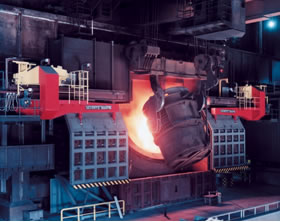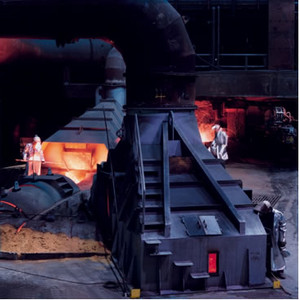In the refractory industry phenolic resins are used in a multitude of applications.
One of the most significant attributes of phenolic resins is their ability to form a “carbon bond”, and this, to a large extent, has contributed to their increased use in this industry, offering a cleaner alternative to the traditional pitch and tar binders. In addition, as the application of carbon bonded products increased within the refractory industry, phenolic resin bonded products have replaced the more traditional, ceramically bonded product used in many areas of molten metal contact.
 Phenolic resins have also been shown to dramatically improve the production rates and consistency of refractories. Their low temperature curing characteristics give dimensional stability and in many applications the final heating of the product to form the carbon bond can be carried out after the product has been installed at the customer. Phenolic resins have excellent compatibility with many refractory raw materials, and demonstrate good adhesion to both oxides and graphite. Furthermore, being a synthetic product, the quality and consistency of the resin can be carefully controlled during manufacture to give a binder with much improved and consistent performance during both refractory manufacture and in final service.
Phenolic resins have also been shown to dramatically improve the production rates and consistency of refractories. Their low temperature curing characteristics give dimensional stability and in many applications the final heating of the product to form the carbon bond can be carried out after the product has been installed at the customer. Phenolic resins have excellent compatibility with many refractory raw materials, and demonstrate good adhesion to both oxides and graphite. Furthermore, being a synthetic product, the quality and consistency of the resin can be carefully controlled during manufacture to give a binder with much improved and consistent performance during both refractory manufacture and in final service.
Refractory Applications
1. Manufacture of Carbon Bonded Brick
Examples of carbon bonded brick include basic bricks composed of magnesia, dolomite (a mix of lime (CaO) and periclase) and alumina based (bauxite) bricks
To successfully bond the refractory aggregates together, the resin binder system must demonstrate the following features:
- Good wetting of the aggregate
- Controlled reactivity with the aggregate
- Development of high green strength (does not pass a plastic phase when heated)
- High carbon yield
- Low environmental impact
- Cost effectiveness
Phenolic resins have been developed over many years to provide all of these features, and the following combinations of phenolic resins can be used to suit many different manufacturing conditions:
- Novolak powders, with/without hexamine
- Novolak liquids
- Molten novolaks
- Water based resoles
- Solvent based resoles
2. Manufacture of Iso-Pressed Products
Examples of iso-pressed products include refractories for molten steel control and crucibles.
Similar performance characteristics are required in this application to the brick binders. Additionally, the rheology/stability of the mix is critical in this application, with consistent binder performance being a key parameter. Combinations of powder resins with solvent, or ‘pre-solvented’ resins, are available for this application.

3. Tap Hole Clay Resins
Binders for tap-hole clay must exhibit many of the same characteristics required for all other refractory applications. However, there are additional considerations that relate to this application, for example tap-hole clays are supplied in an uncured state, so that they harden off in the application area. The resins used in this application must have the following properties:
- High plasticity
- Excellent storage stability
- Low emissions
- Controlled cure rate
- Cost effectiveness
- Tightly controlled consistency
Both liquid novolaks and resols are frequently used in this application.
4. Monolithic applications
Phenolic resins can be used to manufacture monolithic refractories where the refractory material is supplied in loose form to the customer and applied by ramming/vibrating into place. This is followed by a curing process to “set ” the lining. This is a particularly useful process for areas such as blast furnace trough repairs, and tundish linings. Typically, these are dry systems and a novolak powder is used as the binder. The dry nature of the refractory gives very fast turn round after a repair.
5. Why to use phenolic resins for refractory applications?
- To improve production rates and consistency of refractories.
- Low temperature curing characteristics give dimensional stability (high green strength without passing a plastic phase). Because of this the final heating of the product to form the carbon bond can be carried out after the product has been installed at the customer.
- Excellent compatibility with many refractory raw materials
- Good adhesion to both oxides and graphite.
- Low environmental impact
- An alternative to the traditional pitch and tar binders to avoid polycyclic hydrocarbons.
